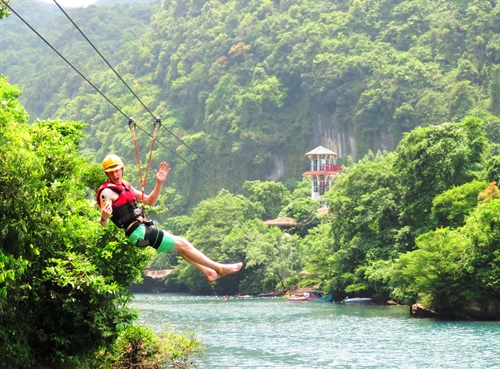 Society
Society

Deputy PM Vương Đình Huệ has promised help from the Government for the tourism sector in the central provinces hit hard by the Formosa environmental disaster.
 |
| A tourist rides a zipline across Chày River to Tối Cave in Quảng Bình Province. Of the four provinces affected by the toxic aftermath of untreated wastewater being illegally discharged into the sea by the Formosa Plastics Group plant, tourism was hit hardest in the central province of Quảng Bình. — VNA/VNS Photo Mạnh Thành |
HCM CITY — Deputy PM Vương Đình Huệ has promised help from the Government for the tourism sector in the central provinces hit hard by the Formosa environmental disaster.
Huệ spoke at a conference held last Friday at the Government Office in Hà Nội about sustainable development of the tourism industry, particularly in the wake of the Formosa incident.
Tourism was hit hardest in the central province of Quảng Bình among the four provinces affected by the toxic aftermath caused by the illegal discharge of untreated waste water from the Formosa Plastics Group plant in the central province of Hà Tĩnh.
The number of tourists in Quảng Bình in recent months fell 20 per cent to 1.3 million, compared to the same period last year, according to the Trần Tiến Dũng, vice chairman of Quảng Bình Province’s People’s Committee.
“Construction on several new hotels and restaurants in the province has been temporarily shelved,” Dũng said. “Investors are waiting for the situation to improve to resume their work.”
Travel companies and hotels in Quảng Bình have had to reduce staff to cut costs due to fewer tourists, while measures taken by the provincial government and local companies have failed to reverse the decline in tourist arrivals.
Besides beautiful beaches, Quảng Bình Province is the site of Son Doong, the world’s largest cave, and Phong Nha-Kẻ Bàng National Park, named a World Heritage site in 2003.
In the central province of Thừa Thiên-Huế, the Formosa disaster has had less of an impact.
Nguyễn Dung, vice chairman of the province’s people’s committee, said the number of tourists to Huế rose by 8 per cent in April, the peak time of the Formosa incident.
Dung attributed the increase to the province’s tourism cooperation with Đà Nẵng City and Hội An in the central province of Quảng Nam.
The province has also combined cultural and religious tourism, along with festival tourism, in a bid to lure more local and foreign visitors.
Gov’t action
Deputy PM Huệ said the Government would cooperate with localities to resolve the Formosa incident but he also noted that the provincial governments must be proactive and creative. He urged them to learn from Thừa Thiên-Huế Province’s tourism initiatives.
He said that provinces still lacked linkages with other areas and that the public needed to be more aware about the importance of tourism.
The Government would continue to fund tourism activities but with more careful consideration, Huệ said, adding that provinces and cities must begin to take the initiative. “Capital is not enough,” he said.
Đặng Việt Dũng, vice chairman of Đà Nẵng’s People’s Committee, said a lack of linkages among localities and effective tourism promotions were part of the problem.
He also pointed out that more Vietnamese were choosing to travel abroad instead of locally on their holidays.
Nguyễn Xuân Bình, vice chairman of the northern port city of Hải Phòng’s People’s Committee, said the tourism industry still faced challenges in competitiveness and sustainable growth, including a shortage of skilled workers and lack of high-quality services.
The negative images of street vendors and overcharging for services, for example, had damaged the tourism industry.
Experts have said that Việt Nam should develop solutions to better balance conservation and economic growth and benefits for communities, businesses and government agencies.
In early April, large quantities of fish washed up near the Vũng Áng Economic Zone in the central province of Hà Tĩnh.
The disaster stretched 200 kilometres along the central Vietnamese coast, as far south as Thừa Thiên-Huế, resulting in the mass death of more than 70 tonnes of fish and 35 tonnes of farm-raised fish.
The hardest hit were Hà Tĩnh, Quảng Trị, Quảng Bình and Thừa Thiên-Huế provinces where thousands of fishermen lost customers or were forced to sell fish at a loss.
In late June, Formosa Hà Tĩnh Steel acknowledged that its $10.6 billion steel plant had been responsible for the massive fish deaths, pledging to pay $500 million to compensate for damages.
The central government has assigned the Ministry of Culture, Sports and Tourism to develop a blueprint that earmarks tourism as a key economic industry of the country. — VNS